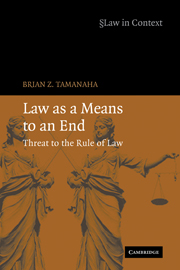Book contents
- Frontmatter
- Contents
- Acknowledgments
- Introduction
- Part 1 The spread of legal instrumentalism
- 1 Non-instrumental views of law
- 2 A changing society and common law in the nineteenth century
- 3 Nineteenth-century legislation and legal profession
- 4 Instrumentalism of the legal realists
- 5 Twentieth-century Supreme Court instrumentalism
- Part 2 Contemporary legal instrumentalism
- Part 3 Corroding the rule of law
- Epilogue
- Index
- Titles in the series
2 - A changing society and common law in the nineteenth century
Published online by Cambridge University Press: 25 July 2009
- Frontmatter
- Contents
- Acknowledgments
- Introduction
- Part 1 The spread of legal instrumentalism
- 1 Non-instrumental views of law
- 2 A changing society and common law in the nineteenth century
- 3 Nineteenth-century legislation and legal profession
- 4 Instrumentalism of the legal realists
- 5 Twentieth-century Supreme Court instrumentalism
- Part 2 Contemporary legal instrumentalism
- Part 3 Corroding the rule of law
- Epilogue
- Index
- Titles in the series
Summary
Legal historians and theorists are in nearly complete agreement that the non-instrumental views of the common law described in the preceding chapter held sway through the eighteenth century. They agree also that the instrumental view of law took hold in the course of the twentieth century. This generally accepted time frame, however, leaves large unanswered questions with respect to the nineteenth century.
Many legal historians appear to accept that legal instrumentalism flowered in the United States in the first quarter of the nineteenth century and lasted until the mid-nineteenth century, when it was supplanted by a lengthy non-instrumental period running from the Civil War until after the turn of the century. The leading source of this chronology of the emergence and subsequent eclipse of instrumental views of law is Morton Horwitz's Transformation of American Law (1977). Horwitz begins his account positing the non-instrumental conception of law: “In eighteenth century America, common law rules were not regarded as instruments of social change; whatever legal change took place generally was brought about through legislation. During this period, the common law was conceived of as a body of essentially fixed doctrine to be applied in order to achieve a fair result between private litigants in individual cases.”
According to Horwitz, after the Revolution, “merchant and entrepreneurial groups” forged an “alliance with the legal profession to advance their own interests through a transformation of the legal system.”
- Type
- Chapter
- Information
- Law as a Means to an EndThreat to the Rule of Law, pp. 24 - 40Publisher: Cambridge University PressPrint publication year: 2006

